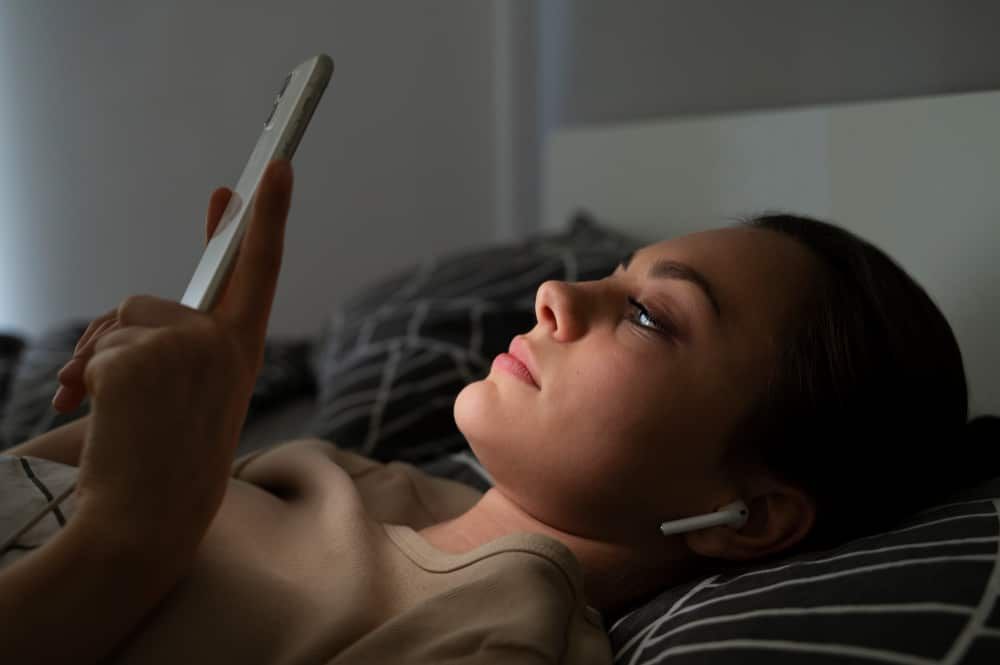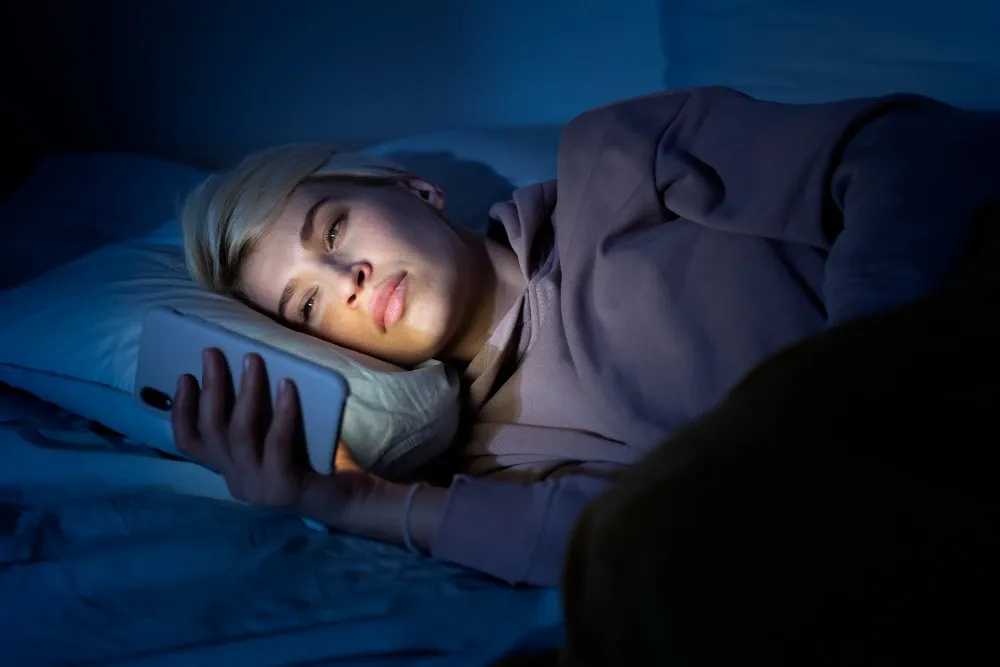Can Screen Time Cause Dark Circles and Eye Bags? Let’s Clear It Up
“I sleep 7 hours, drink water, and use eye cream. Still, I wake up looking tired.”
This quote, from a Reddit user in a screen-time recovery thread, received over 2,000 upvotes in a day. It hit a nerve. Because most people struggling with under-eye shadows aren’t lazy, careless, or unhealthy.
They’re simply living in a world of screens.
So if you’ve ever wondered does screen time cause dark circles or does screen time cause eye bags, you’re asking the right question. And the answer, though layered, is yes. But not in the way most people think.
First, Understand What’s Happening Under Your Eyes
Let’s break down the two symptoms:
- Dark circles are usually caused by poor blood flow, thinning skin, or hyperpigmentation. They become more visible when you’re tired or stressed.
- Eye bags are a result of fluid buildup and inflammation. They tend to swell when your sleep is poor, your diet is unbalanced, or your body is under consistent strain.
Now enter screen time.
It touches nearly every one of these causes.
So, Does Screen Time Cause Dark Circles and Eye Bags?
Yes, screen time contributes directly and indirectly to under-eye issues. Here’s how:
1. Sleep Disruption from Blue Light
The blue light emitted from screens interferes with melatonin production, making it harder for your brain to prepare for rest. A
study in the Journal of Applied Physiology showed that blue light exposure before bed delays REM sleep and increases nighttime awakenings. This affects collagen repair and fluid drainage, two processes essential to under-eye health.
2. Digital Eye Strain and Blood Pooling
Extended focus on screens leads to eye strain, reduced blinking, and poor circulation around the eyes. This causes blood vessels under the skin to become more visible, leading to darker circles. According to a study published in Clinical Ophthalmology, people who use screens for over 4 hours daily are more likely to experience tear film instability and vascular congestion near the eyes.
3. Chronic Inflammation from Fatigue
The longer you spend on screens, the more cortisol (the stress hormone) builds in your system. Elevated cortisol leads to water retention and inflammation, which shows up as puffiness, especially under the eyes. These aren’t just cosmetic symptoms. They are early signs of a system under strain.
So the next time you ask does screen time cause dark circles or does screen time cause eye bags, recognize the layers. The effects are slow, quiet, and cumulative, but are very real.
Check out the Jolt app
So What Can You Do? Don’t Just Cover It. Change It.
1. Reset Your Sleep Signals with a 60-Minute Screen-Free Buffer
You may be in bed by 11, but if you’ve been scrolling until 10:59, your brain hasn’t had a chance to slow down.
What to do:
Create a consistent pre-sleep wind-down routine. One hour before bedtime, shut down all screens like phone, tablet, TV, even e-readers with backlit displays. Replace them with:
Dim bedside lighting
- 5–10 minutes of light stretching or yoga
- A non-stimulating book
- Simple breathwork (like 4-4-4 box breathing)
Why it matters:
A Harvard Medical School study found that blue light exposure in the hour before sleep can delay melatonin release by up to 90 minutes. Melatonin is essential for initiating deep sleep and triggering the repair mechanisms that reduce puffiness and improve blood vessel recovery under the eyes. Without it, your face begins to reflect chronic sleep debt.
2. Use the 20-20-20 Rule to Improve Microcirculation
Most people blink 50–60% less when looking at screens, according to the Journal of Ophthalmology. That reduced blinking dries the eyes, strains surrounding muscles, and constricts blood flow to the under-eye area.
What to do:
Set a digital timer or app-based reminder to pause every 20 minutes. During each pause:
- Look at an object 20 feet away for at least 20 seconds
- Gently close your eyes for 10 more seconds after that
- Take a few slow, deep breaths before returning to the task
Why it matters:
This practice not only reduces strain but also encourages blinking, which keeps your tear film stable and improves blood oxygenation in the periorbital region. Over time, this helps reduce the vascular congestion that leads to dark circles.
3. Cool Compresses and Morning Lymphatic Massage
Digital fatigue leads to fluid retention under the eyes, especially when combined with poor sleep. That puffiness doesn’t just go away with time, it needs help to drain.
What to do:
Each morning, keep a chilled spoon, reusable gel pad, or jade roller in the fridge. Once your face is cleansed:
- Start at the inner corner of your under-eye area
- Roll or press outward toward your temple in slow, light strokes
- Repeat 5–10 times per eye
- You can also tap lightly with your ring finger to stimulate circulation
Why it matters:
This supports lymphatic drainage and increases blood circulation. A
study published in Healthline found that regular massage in the under-eye region reduces puffiness and helps normalize skin tone by improving capillary flow.
4. Let Jolt Handle Boundaries When You’re Mentally Tired
It’s hard to
track screen time habits when you’re already mentally drained. That’s when defaulting to overstimulation becomes second nature. What you need in those moments isn’t more discipline. You need systems that make rest the easier choice.
What to do with Jolt:
- Evening Sessions: Set up an automatic screen-free window starting 90 minutes before bedtime. This takes the decision off your plate and supports your melatonin cycle consistently.
- Breathe Screen: Every time you open a commonly overused app, Jolt gives you a short pause with a breathing prompt. This tiny break often helps you realize you didn’t even need to open that app.
- Streaks: Jolt tracks your consistent focus days and turns them into visual streaks — so you can see your discipline grow, even when it doesn’t feel like it. Momentum is motivation.
Why it matters:
By removing the need for willpower and introducing gentle friction, Jolt supports long-term behavioral change.
Studies in Behavioral Neuroscience confirm that small interruptions in habit loops can significantly reduce compulsive checking behaviors and help restore balance to dopamine-reward systems, reducing overstimulation, especially at night.
Final Word: Your Eyes Speak Before You Do
Dark circles and eye bags are messages. They reflect tension, overstimulation, and exhaustion. But they also respond to care.
So if you’ve been wondering does screen time cause dark circles, the answer is yes.
If you’re searching does screen time cause eye bags, the answer is yes again.
But you’re not stuck with it.
You can reverse the damage, one session, one pause, one night of deep sleep at a time.
Your reflection doesn’t lie, but it can heal. And your eyes will thank you for every moment of quiet you create for them.
Check out the Jolt app
FAQs:
- Does screen time cause dark circles under the eyes?
Yes, long screen exposure can lead to dark circles by disrupting sleep and causing eye strain. Blue light from screens delays melatonin production, which affects sleep quality. Poor sleep weakens circulation and makes blood vessels under the thin eye skin more visible, creating a darker appearance.
- Can too much screen time cause eye bags or puffiness?
Excessive screen time may lead to eye bags due to fluid retention and inflammation. When the eyes are overworked and dry, they often become irritated, which causes the body to retain fluid in nearby tissues. This puffiness is a sign your eyes need rest and regulation, not just more caffeine or concealer.
- Why do my eyes look tired even when I get enough sleep?
Sleep is important, but it’s only part of the equation. If you’re spending most of your day on screens, your eyes may still be strained, under-lubricated, or experiencing reduced circulation. This creates a tired look, even with 7 to 8 hours of sleep. Taking visual breaks and limiting screen use at night can help restore a fresher appearance.
- How long before bed should I stop using screens to protect my eyes?
Experts recommend stopping screen use at least 60 minutes before bedtime. This allows melatonin levels to rise naturally and supports deep sleep cycles. Better sleep means better collagen repair, less fluid retention, and fewer signs of fatigue under your eyes the next morning.
- What are simple daily habits that help reduce screen-related dark circles?
Try the 20-20-20 rule: every 20 minutes, look at something 20 feet away for 20 seconds. In the morning, use a cool compress or massage tool to reduce puffiness. Most importantly, wind down at night without screens. These simple habits improve circulation, reduce inflammation, and help your under-eye area recover.
- How can Jolt help reduce screen time-related eye strain and fatigue?
Jolt helps you build better screen habits with less effort. You can schedule wind-down Sessions that automatically block apps before bedtime, use the Breathe Screen to pause before opening distractions, and track your Streaks to stay consistent. These tools give your eyes the break they need—without needing to rely on willpower at the end of a long day.



 Dr. Manish Singh
Dr. Manish Singh